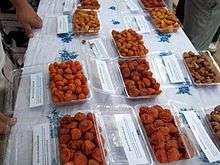Dried apricot



Dried apricots are a type of traditional dried fruit. When treated with sulfur dioxide (E220), the color is vivid orange. Organic fruit not treated with sulfur vapor is darker in color and has a coarser texture.[1] Generally, the lighter the color, the higher the SO2 content.[2] Light-colored varieties (with the sulfur content of more than 2000 ppm) are banned in the European Union.[3]
Apricots have been cultivated in Central Asia since antiquity, and dried ones were an important commodity on the Silk Road. They could be transported over huge distances due to their long shelf life. Before the 20th century, they were ubiquitous in the Ottoman, Persian, and Russian Empires. In more recent times, California was the largest producer, before being overtaken by Turkey,[4] where about 95% of the production is provided by the Malatya Province.[5]
Small apricots are normally dried whole. Larger varieties are dried in halves, without the kernel. In the former Soviet Union, the former are known as uryuk (урюк), used primarily for making kompots, and the latter as kuraga (курага).[6] Ethnic foods based on dried apricots include qubani ka meetha in India and chamoy in Mexico.
Dried apricots are an important source of carotenoids (vitamin A) and potassium.[7] Due to their high fiber-to-volume ratio, they are sometimes used to relieve constipation or induce diarrhea.[8] Dried apricots normally do not have any sugar added and have a low glycemic index.[9] The maximum moisture rate allowed in Turkey is 25%.[10]
See also
References
- ↑ Bittman, Mark (2011-12-19). How to Cook Everything Vegetarian: Simple Meatless Recipes for Great Food. Houghton Mifflin Harcourt. ISBN 0544186958.
- ↑ "Dried Apricots, Natural, sulphured, organic. | Fruits of Turkey". www.fruitsofturkey.com. Retrieved 2016-05-08.
- ↑ http://www.malatyaapricots.com/bazimakaleler/Chronica%20hort.pdf
- ↑ The Oxford Companion to American Food and Drink (ed. Andrew F. Smith). Oxford University Press, 2007. ISBN 9780195307962. Page 22.
- ↑ Kemal Esengün, Orhan Gündüz, Gülistan Erdal Gaziosmanpaşa University, Tokat). Abstract: "Input–output energy analysis in dry apricot production of Malatya, Turkey" Check
|url=value (help). Energy Conversion and Management, ScienceDirect, Elsevier, the Netherlands. - ↑ Консервирование. Большая книга рецептов (in Russian). Litres. 2015-04-22. ISBN 9785457428713.
- ↑ Ellison, Bronwyn. "About Dried Apricots". LIVESTRONG.COM. Retrieved 2016-05-08.
- ↑ Karin Cadwell, Edith White. The Natural Laxative Cookbook. Sterling Pub Co Inc, 1995. ISBN 9780806913445. Page 17.
- ↑ http://www.livestrong.com/article/87932-dried-apricots/
- ↑ AgricultureKey. "Turkish Dried Apricot". www.agriculturekey.com. Retrieved 2016-05-08.
External links
-
 Media related to Dried apricots at Wikimedia Commons
Media related to Dried apricots at Wikimedia Commons